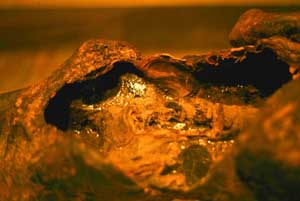|
|
 56 mummies DHJanzen100295.jpg high resolution
|
|
| In essence, the insect trapped in amber has been mummified in tree resin. Peer into the abdominal cavity of this Egyptian mummy and you see something glistening. It is not wet, but rather is encased in a hard layer of resin - essentially, varnish. Embalming with naturally harvested secondary compounds is a very old practice. The trick was to saturate the human tissue with such a dose of secondary compounds that not even microbes could survive there. However, the embalmer had dryness on his/her side (it is no accident that mummies tend to be left by arid-land occupying peoples, such as those of Egypt and Peru). Wetting of secondary compound-rich tissues generally results, eventually, in their biodegredation because with water present, both the compounds bind less permanently to the animal tissues, and with water present, microbes can make enzymes that can degrade both the animal tissues and the secondary compounds. I should add that if it is salty water, biodegredation happens even faster - the mineral ions interfere with the binding of the organic secondary compounds with other organic tissues. | ||
back to lecture slides
or skip to: